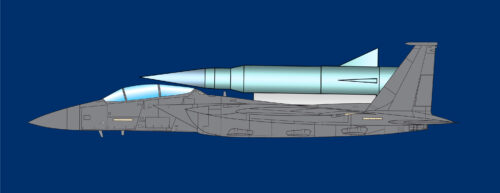Imagine seeing an F-15E Strike Eagle with no souls onboard take off with a large missile mounted on top of the fueslage, it’s a pretty cool sight to behold. In 2006, Boeing proposed an unmanned variant of the F-15E Strike Eagle, called the F-15 Global Strike Eagle (GSE), for air-launching missiles with the launch vehicle mounted dorsally.

Image: USAF
One of the munitions being proposed was the Common Aero Vehicle (CAV), a maneuverable, hypersonic reentry vehicle that can release different types of payloads while inside the atmosphere.
The proposed CAV was made up of off-the-shelf components such as the SR-19 rocket, a Minutemen II second stage used as the first stage of the launch vehicle. The second stage of the launch vehicle would have used the Orion 50XL, while the third stage used the Orion 38, both from the Pegasus XL launch system. The large size of the launch vehicle would have impaired pilot ejection capability and thus, it required an unmanned mission. Aerodynamic control surfaces were added to enhance boost phase control, while an aft cone fairing was added to decrease drag during the F-15 boost phase, which was jettisoned shortly after launch vehicle separation.
Research indicates that the conventional method of mounting payloads on the wing or center of an F-15E limited the aircraft’s payload capacity to around 220 pounds (100 kg) while also constraining the size and dimensions of the launch vehicle (LV). By instead by positioning the LV on top of the F-15E, it would allow for greater flexibility and an increased payload capacity.
The F-15 Global Strike Eagle (GSE) would require only minimal adjustments to the upper fuselage structure to support the top-mounted missile pylon. Four primary bulkheads of the fuselage structure provide the 8 mount points needed for the launch pylon attachment. Higher thrust Pratt & Whitney F100-229 engines will be installed and existing flight control software from unmanned air vehicles will be adapted to allow the fighter to fly unmanned while retaining a manned capability for ferry missions.
The F-15 GSE will make a dive to reach Mach 1.7 before pitching up at 27,000 ft. The CAV will then separate from the F-15 at around 48,000 ft with the jet reaching the speed of Mach 1.35. The CAV will ignite its first-stage rocket at 51,000ft and six minutes later the payload will separate from the CAV near Mach 27 at 620,500ft.
While the proposed F-15 Global Strike Eagle (GSE) system would have offered several advantages, including an operationally responsive capability for launching space and munitions payloads, a low-profile mission that would not stand out from other F-15 aircraft, low system development costs, the possibility of using forward basing options and recall capability for mission flexibility, and the potential for future upgrades. In the end, the U.S. Air Force did not move forward with the project and the CAV concept eventually merged with the Air Force/DARPA Falcon project.
For more information, hit the Source below

I favor using old F-15Es for a crew operated. ASAT aircraft to match ASAT aircraft operated by Russia and China. In 1984, our Congress voted to cancel the ASAT F-15A program due to fears this would lead to a nuclear war once we took out a hostile country’s satellites.
Until both Russia and China agreed to deactivate their ASAT aircraft, we would deactivate ours, too. I wonder if a divided Congress would agree to let us have ASAT aircraft to counter Russia’s and China’s ASAT aircraft.